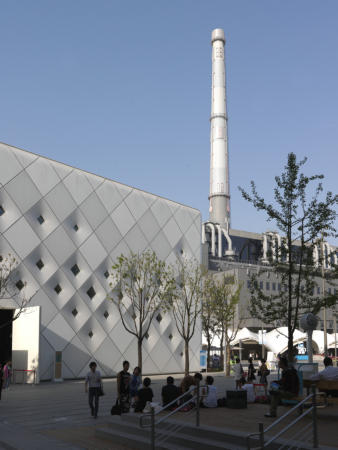|
|


ADVERTISEMENT
Buy Your own advertising
spaces!
.
Download Adobe Acrobat Reader to open [PDF] files.
Recent Visitors
Designing a sustainable future
2010. 11 May
 Murialdo's pavilion in the Urban Best Practices Area at World Expo in Shanghai.(Photo: Luciano Romano)
Murialdo's pavilion in the Urban Best Practices Area at World Expo in Shanghai.(Photo: Luciano Romano)
by Yue Hongyan
(life.globaltimes.cn)
As visitors to World Expo in Shanghai began to experience the diversified concepts of building a better future last week, many of the world's leading architects and designers behind the concepts gathered in Beijing to share their visions of creating a low-carbon sustainable world.
"Basically, designers need to have the vision of building spaces that accord with environmental protection and energy conservation, such as making full use of solar energy, natural light and natural ventilation" explained He Jingtang, the 72-year-old Chinese architect behind the China Pavilion at Expo.
He was a presenter and one of 4,000 delegates attending the 5th China International Design & Art Fair that offered a host of forums, industry gatherings and a design award ceremony, the five-day event setting low carbon, green buildings and sustainability as its focus.
He explained how the China Pavilion realized its low carbon and sustainability goals with solar photovoltaic panels on the roof and walls of the pavilion to illuminate the inside via green power and a rain collection system on the roof enabling recycled water to be used for greening, irrigation and cleaning.
"We maximized the natural light inside the pavilion and minimized energy consumption," explained Italian architect Eugenia Murialdo when describing a pavilion in Expo's Urban Best Practices Area. Murialdo transformed an old factory into a low-carbon sustainable building, adding a skylight on a 30-degree north-facing slope for maximum sunshine collection.
She explained that simple things like minimizing air conditioning are essential and that in realizing low-carbon structures, four aspects should be considered: the use of light, energy consumption, new technology and the different ways of using traditional materials.
"Functionality is also important," 29-year-old Xiao Wei, the youngest Top Ten Innovative Designers of 2009- 2010, an award given at the fair, told the Global Times. "If you design a layout that is functional, it should encompass energy conservation and low-carbon sustainability."
Xiao said that a good example is Northwest Hydro Consulting Engineers' building in Shaanxi Province, which uses a light-pipe system on the roof and ground to transfer sunshine to underground dining rooms.
Murialdo further explained that using the natural environment is very important. She said that when her team designed a wine factory in Italy, they utilized local concrete and hid the structure inside a mountain, instead of destroying the surrounding environment.
The vision of coexistence of buildings and the natural environment is also applicable to urban planning, according to Murialdo, citing her company's design for Haihe district in Tianjin that considers the use of green space and public space in the city like the outline of a hand, stressing the need for the "reasonable function of the city" to make "life sustainable."
"Architecture can also offer a platform for better communication between people, between the city and people, which can realize real happiness," Giampaolo Imbrighi, the Italian designer of the Italian Pavilion said Saturday during a lecture in Beijing. With narrow streets, plazas and lanes of the Middle Ages (476-1453), the Italian Pavilion represents Imbrighi's vision in which future structures should make a return to nature and the essence of human beings, that is, according to him, "the real sustainability."
With a plethora of innovative ideas on the table, some designers attending the Beijing fair raised the issue of the monetary and physical outlays involved in going low carbon.
"The cost of green building is quite high, both in money and time and a main problem is whether developers and governments have the patience for long-term and sustainable development," stated Ouyang Kunlun, co-founder of Beijing Fanghe Architecture and Design.
"For low carbon, many people take it only as a slogan for commercial use," added Xiao Wei.
Gregor Hoheisel, the German architect behind internationally-renowned Graft Lab in Beijing, said that many architectural and interior designs in China are decided by developers themselves, looking for quick investments and returns, with little concern for sustainable development or the environment.
He suggested that a practical way to apply sustainability in China today is with the concept of "lowering carbon," instead of emphasizing zero carbon. He said that stricter standards should be implemented by law, in accordance with new regulations, as the German government has done.
Source: life.globaltimes.cn

